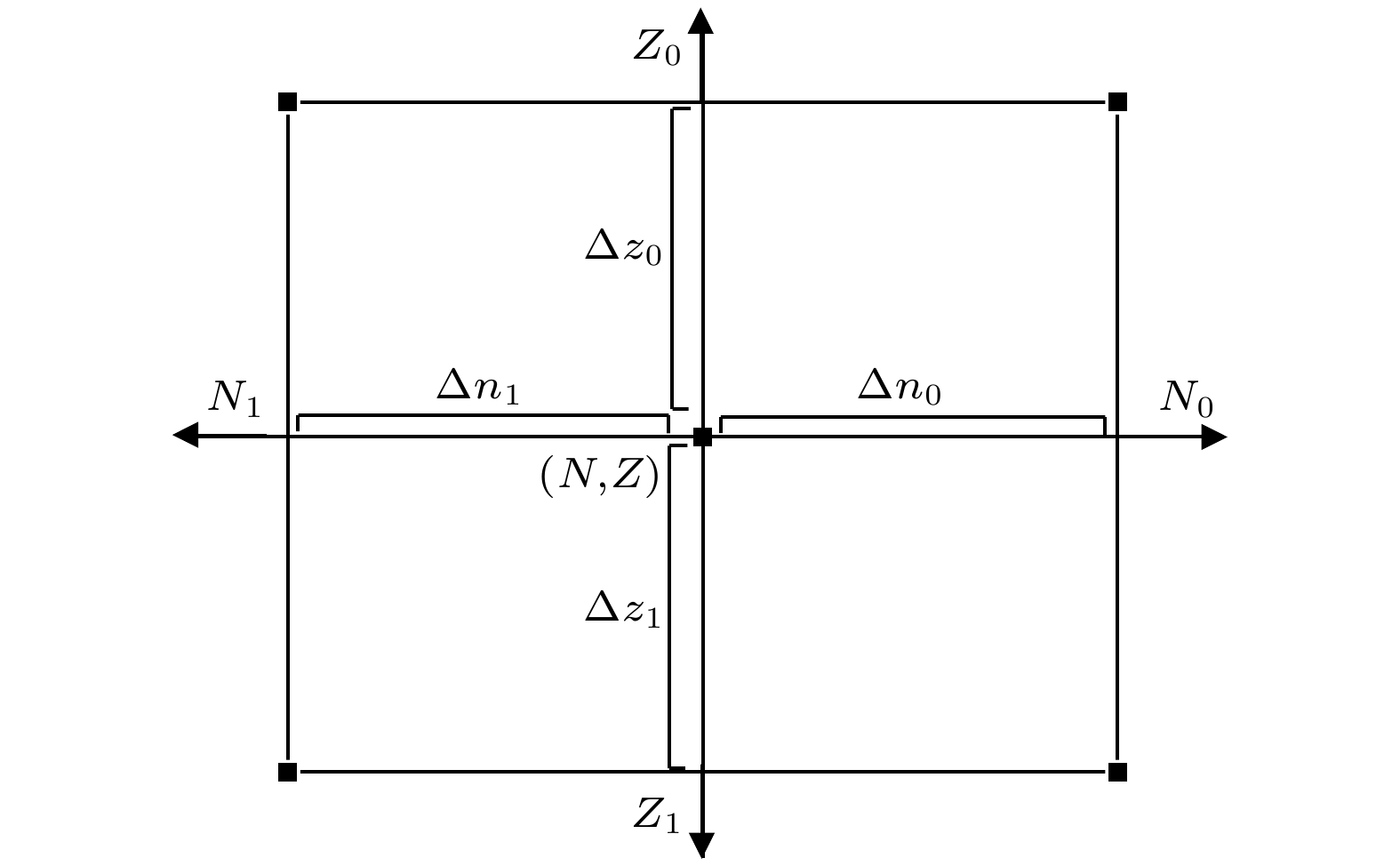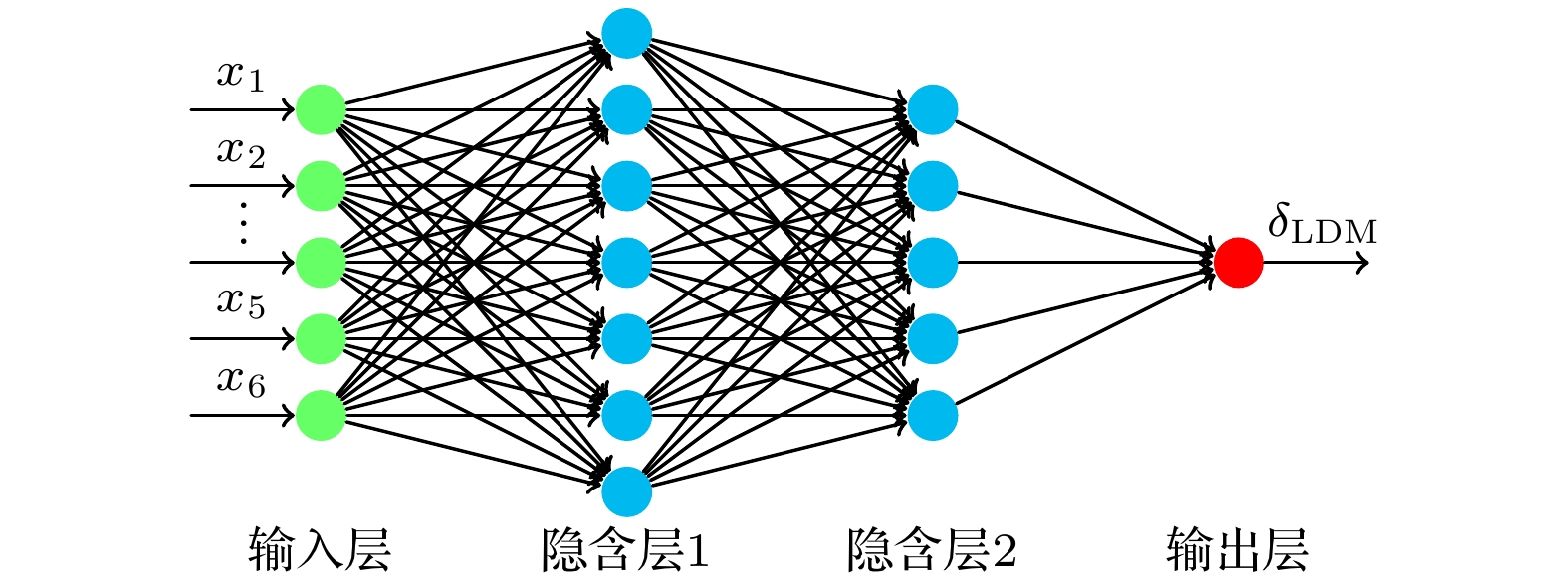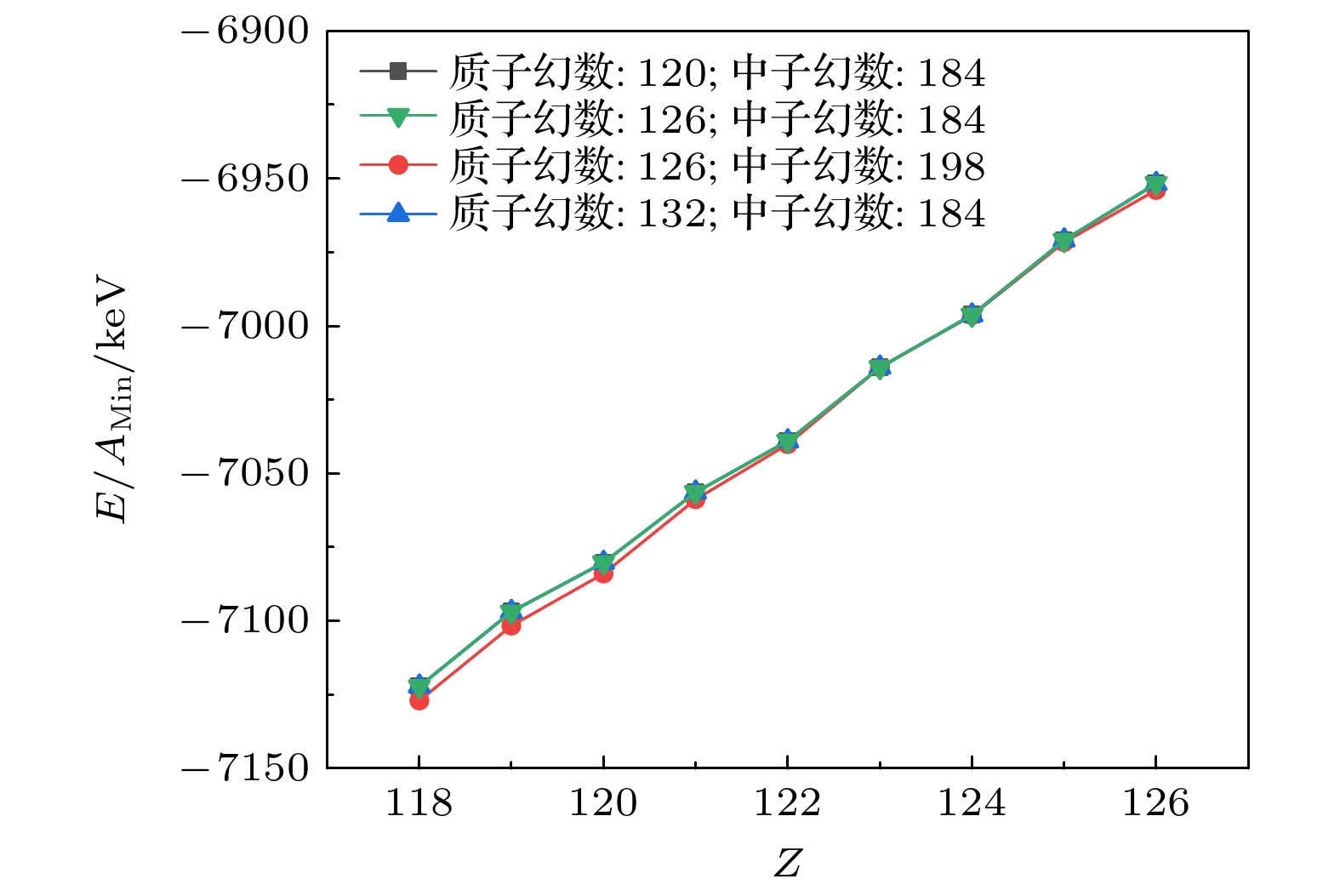-
采用贝叶斯深度神经网络对液滴模型进行优化改进, 并运用KL (Kullback-Leibler)散度与变分推断的方法使得模型便于实现. 以最新的原子核数据(AME2020)中2457个有精确值的原子核(
$Z\geqslant 8$ 和$N\geqslant 8$ )作为总数据集, 随机选取其中80%的数据为训练集用于模型训练, 通过预测余下的20%进行模型验证. 最终两个数据集的误差均方根(RMS)基本相等, 而且全部数据的RMS从2.9894 MeV降到0.5695 MeV, 下降了80%, 呈现出较好的结果. 此模型进行了输入参数上的改进(区域限定策略), 使得未知核($Z = 118—126$ )可以被限定在一个固定的区域内, 从而提高了预测的准确性. 为了验证这一性质, 对实验数据($Z=100— 117$ )进行了预测计算, 结果也与实验值符合得很好. 最后使用该方案对未知元素$Z = 118—126$ 进行了预测, 为以后寻找新元素提供了新思路.Liquid drop model accuracy is optimized 80% by Bayesian deep neural network (BDNN) to calculate the known nuclei binding energies and also used to predicate extra unknown nucleus. In this paper, KL(Kullback-Leibler) divergence from BDNN is adopted and further optimized by the variational reasoning method. The latest atomic data (AME 2020) is taken as input to train the BDNN, the root means square(RMS) of 2457 types known nuclei ($Z\geqslant 8$ and$N\geqslant 8$ ) calculation is improved 80% (from 2.9894 MeV to 0.5695 MeV). Additionally, we improved the input of BDNN in this work, so that the unknown nucleus (Z = 118–126) can be limited in a region(Regional restriction strategy), which improves the stability of prediction. Experimental data (nuclei Z = 100–117) also match well with our prediction and showed this calculation method is promising. The further binding energy for proton numbers from 118–126 is predicate using our method.-
Keywords:
- binding energy /
- BDNN /
- liquid drop model /
- regional restriction strategy
[1] Lunney D, Pearson J M, Thibault C 2003 Rev. Mod. Phys. 75 1021
 Google Scholar
Google Scholar
[2] Schatz H, Blaum K 2006 Europhysics News. 37 16
 Google Scholar
Google Scholar
[3] Dong J, Zhang H, Wang L, Wei Z 2013 Phys. Rev. C 88 014302
[4] Kanungo, Rituparna 2013 Phys. Scr. T152 4002
[5] Jorge C, Peter G. J, Garik I 2017 X-Ray Binaries. In: Alsabti A., Murdin P. (eds) Handbook of Supernovae. Springer, Cham. https://doi.org/10.1007/978-3-319-20794-0_111-1
[6] Wallerstein G, Iben I, Parker P, Boesgaard A M, Hale G M, Champagne A E, Barnes C A, Käppeler F, Smith V V, Hoffman R D, Timmes F X, Sneden C, Boyd R N, Meyer B S, Lambert D L 1997 Rev. Mod. Phys. 69 995
 Google Scholar
Google Scholar
[7] Schatz H, Aprahamian A, GGöRres J, Wiescher M, Rauscher T, Rembges J F, Thielemann F K, Pfeiffer B, Möller P, Kratz K L, Herndl H, Brown B A, Rebel H 1998 Phys. Rep. 294 167
 Google Scholar
Google Scholar
[8] Bosch F 2003 J. Phys. B 36 585
 Google Scholar
Google Scholar
[9] Haozhao L, Nguyen V G, Jie M 2009 Phys. Rev. C 79 064316
 Google Scholar
Google Scholar
[10] Hardy J C, Towner I S 2015 Phys. Rev. C 91 025501
 Google Scholar
Google Scholar
[11] Goriely S, Chamel N, Pearson J M 2013 Phys. Rev. C 88 101
[12] Geng L, Hiroshi T, Meng J 2005 Prog. Theor. Phys. 113 785
 Google Scholar
Google Scholar
[13] Royer G, Subercaze A 2013 Nucl. Phys. A 917 1
[14] Myers W D, Swiatecki W J 1996 Nucl. Phys. A 601 141
 Google Scholar
Google Scholar
[15] Duflo J, Zuker A P 1995 Phys. Rev. C 52 R23
 Google Scholar
Google Scholar
[16] Moller P, Myers W D, Sagawa H, Sagawa H, Yoshida S 2012 Phys. Rev. Lett. 108 052501
 Google Scholar
Google Scholar
[17] Moller P, Nix J R, Myers W D, Swiatecki W J 1993 At. Data Nucl. Data Tables 59 185
[18] Haifei Z, Jianmin D, Nana M G R, Junqing L, Zhang H F 2014 Nucl. Phys A 929 38
 Google Scholar
Google Scholar
[19] Muntian I, Patyk Z, Sobiczewski A 2001 Acta Phys. Pol. 32 691
[20] Ning W, Min L 2011 Phys. Rev. C 84 051303
 Google Scholar
Google Scholar
[21] Ning W, Min L, Xizhen W, Jie M 2014 Phys. Lett. B 734 215
 Google Scholar
Google Scholar
[22] Salamon P, Kruppa A T 2010 J. Phys. G: Nucl. Part. Phys. 37 10
[23] Gazula S, Clark J W, Bohr H 1992 Nucl. Phys. A 540 1
 Google Scholar
Google Scholar
[24] Utama R, Piekarewicz J, Prosper H B 2016 Phys. Rev. C 93 014311
 Google Scholar
Google Scholar
[25] John C W, Chen H 2006 Int. J. Mod. Phys. B 20 5015
[26] Blaum K 2006 Phys. Rep. 425 1
 Google Scholar
Google Scholar
[27] David J C, Mackay 2009 Comput. Neural Syst. 6 469
[28] Zhang H, Wang L, Yin J, Chen P, Zhang H 2017 J. Phys. G 44 045110
 Google Scholar
Google Scholar
[29] Bhagwat A 2014 Phys. Rev. C 90 064306
 Google Scholar
Google Scholar
[30] Bhagwat A, Viñas X, Centelles M, Schuck P, Wyss R 2010 Phys. Rev. C 81 044321
[31] Huang W J, Meng W, Kondev F G, Audi G, Naimi S 2021 Chin. Phys. C 45 030002
 Google Scholar
Google Scholar
[32] Charles B, Julien C, Koray K, Daan W 2015 arXiv: 1505.05424[stat.ML]
[33] Radford M N 1995 Bayesian Learning for Neural Networks , Lecture Notes in Statistics 118
[34] Sobiczewski A, Litvinov Y A, Palczewski M 2017 Detailed Illustration of Accuracy of Presently Used Nuclear-mass Models Atomic Data & Nuclear Data Tables 119:1-32.
[35] Rather Asloob A, Ikram M, Usmani A. A, Kumar B, Patra S. K 2017 Braz. J. Phys. 47 1678
[36] Sil T, Patra S K, Sharma B K, Centelles M, Vinas X 2004 Phys. Rev. C 69 044315
 Google Scholar
Google Scholar
[37] Denisov V Y 2005 Phys. At. Nucl. 68 1133
 Google Scholar
Google Scholar
[38] Li F, Zhu L, Wu Z H, et al. 2018 Phys. Rev. C 98 014618
 Google Scholar
Google Scholar
[39] Sridhar K N, Manjunatha H C, Ramalingam H B 2018 Phys. Rev. C 98 064605
 Google Scholar
Google Scholar
[40] Manjunatha H C, Sridhar K N, Sowmya N 2018 Phys. Rev. C. 98 024308.
[41] Wang M, Audi G, Wapstra A H, Kondev F G, MacCormick M, Xu X, Pfeiffer B 2012 Chin. Phys. C 36 1603
 Google Scholar
Google Scholar
[42] Dong X X, An R, Lu J X, Geng L S 2022 arXiv: 2109.09626[nucl-th]
[43] Djärv T, Ekström A, Forssén C, Johansson H. T 2021 arXiv: 2108.13313[nucl-th]
[44] Wang Z A, Pei J C, Liu Y, Qiang Y 2019 Phys. Rev. Lett. 123 122501
 Google Scholar
Google Scholar
[45] Dan P, Wei H L, Chen X X, Wei X B, Wang Y T, Pu J, Cheng K X, Ma C W 2021 arXiv: 2109.01388[nucl-th]
-
图 1 假设原点为给定原子核, 取上下左右4个幻数与其的差值作为限定条件, 近似地将给定核限定在一个固定范围内, 进而起到提高稳定计算与外推未知核结合能的作用
Fig. 1. The origin is assumed to be a given nucleus, and the difference between the four magic numbers above, below, left and right is taken as the limiting condition to approximately limit the given nucleus within a fixed range, thus improving the stability calculation and extrapolating the binding energy of unknown nuclei.
图 3
${\text{δ}} E$ 为2457个核素的实验值与理论计算值的误差均方根, 其中黑点为LDM模型的理论计算值, 红点为LDM+BDNN模型的理论计算值Fig. 3.
${\text{δ}} E$ is the root mean square error of the experimental values and theoretical values of 2457 nuclear, the black spots are theoretical calculation value of LDM model, red dots are the LDM + BDNN theoretical calculation values of the model.图 4 (a)所有2457个核素的误差均方根的核素图; (b)随机选取的491个预测核素的核素图. 其中的颜色代表实验数据与LDM+BDNN计算值的结合能误差均方根
Fig. 4. (a) The root mean square error radionuclide diagram for all 2457 nuclides; (b) random selection of 491 predicted nuclides. The color represents the experimental data and the calculated value of the LDM + BDNN binding energy of the root mean square error.
图 5 Si, Nd 和 Hg原子及其同位素的单、双中子分离能随N的变化, 上排为单中子分离能
$ S_{{\rm{n}}} $ , 下排为双中子分离能$ S_{2 {\rm{n}}} $ , 实验值由AME2020提供(黑色方块), 理论计算值由LDM+BDNN计算得出(红色圆点). 插图给出了误差Fig. 5. Si, Nd and Hg atoms and their
$ (S_{{\rm{n}}}, S_{2{\rm{ n}}}) $ vary with N. The upper row is$ S_{{\rm{n}}} $ , and the lower row is$ S_{2{\rm{ n}}} $ . Experimental values are provided by AME2020 (black squares), and theoretical values are calculated by LDM+BDNN (red dots).The insets are the errors图 6 轻、中、重核
$ (8—90, 91— 180, 181—270) $ 在奇偶效应区分下的误差均方根示意图 (a) LDM的计算结果; (b) LDM+BDNN的计算结果Fig. 6. The schematic diagram of root mean square error of light, medium and heavy nuclei
$(8—90, 91—180, 181— $ $ 270)$ under parity effect differentiation: (a) the calculation result of LDM; (b) the calculation result of LDM+BDNN图 8 (a)使用区域限定策略与BDNN的结合, 预测在(126, 184)区域内未知的超重核, 星号为本文预测的未知超重核; (b)外推结果(
$ Z = 50—126 $ )与实验结果($ Z = 50— 126 $ )的范围对比, 其中红色的阴影为实验值, 蓝色为预测值, 外部虚线为整体变化趋势, 内部虚线为重核变化趋势Fig. 8. (a) Predicted the unknown superheavy nuclei in the region (126, 184) using the combination of the region limiting strategy and BDNN, the asterisk is the unknown superheavy nuclei predicted; (b) the range comparison between extrapolation results (
$ Z = 50— 126 $ ) and experimental results ($ Z = 50— 126 $ ). The red shadow is the experimental value and the blue is the predicted value. The outer dotted line shows the overall trend, while the inner dotted line shows the core trend.表 1 液滴模型所有参数的最佳值
Table 1. The best value of all parameters in the LDM
系数名称 $a_{ {\rm{v} } }/{\rm{MeV}}$ $ a_{{\rm{s}}}/{\rm{MeV}} $ $ k_{{\rm{v}}} $ $ k_{{\rm{s}}} $ $ a_{{\rm{c}}}/{\rm{MeV}} $ $ f_{{\rm{p}}}/{\rm{MeV}} $ $ d_{{\rm{n}}}/{\rm{MeV}} $ $ d_{{\rm{p}}}/{\rm{MeV}} $ $ d_{{\rm{np}}}/{\rm{MeV}} $ 系数值 –15.4299 18.0212 –1.6193 –0.8138 0.7034 –1.4511 5.6149 5.5802 –4.9721 误差 0.0001 0.0001 0.0011 0.0010 0.0001 0.0014 0.1854 0.1321 1.100 表 2 对于AME2020中提取的2457个实验数据采用LDM和LDM+BDNN模型进行运算. 给出训练集(1966)、预测集(491)以及整体核素的理论计算结果与实验值的误差均方根
Table 2. LDM and LDM+BDNN models were used to calculate 2457 experimental data extracted from AME2020. The RMS of error between the theoretical calculation results and experimental values of the training set (1966), the prediction set (491), and the whole nuclide are given.
训练集(80%) 预测集(20%) 全局
计算${\rm{LDM} }_{\sigma_{ {\rm{pre} } }/{\rm{MeV}}}$ 3.0114 2.9374 2.9894 ${\rm{LDM} }+{\rm{BDNN} }_{\sigma_{ {\rm{post} } }/{\rm{MeV}}}$ 0.5675 0.5565 0.5695 表 3 LDM+BDNN与其他全局模型计算结果的对比
Table 3. Comparison of calculation results of LDM+BDNN with other global models.
模型 LSD FRDM FRDM12 TF HFB21 GHFB KTUY Bhagwat LMNN LDM+BDNN 数据年份 AME2012 AME2012 AME2012 AME2012 AME2012 AME2012 AME2012 AME2012 AME2012 AME2020 $N_{{\rm{nucl}}}$ 2316 2353 2353 2353 2353 2353 2353 2353 2353 2457 $\sigma_{{\rm{rms}}}$/MeV 0.608 0.654 0.579 0.649 0.572 0.789 0.701 0.266 0.235 0.5695 -
[1] Lunney D, Pearson J M, Thibault C 2003 Rev. Mod. Phys. 75 1021
 Google Scholar
Google Scholar
[2] Schatz H, Blaum K 2006 Europhysics News. 37 16
 Google Scholar
Google Scholar
[3] Dong J, Zhang H, Wang L, Wei Z 2013 Phys. Rev. C 88 014302
[4] Kanungo, Rituparna 2013 Phys. Scr. T152 4002
[5] Jorge C, Peter G. J, Garik I 2017 X-Ray Binaries. In: Alsabti A., Murdin P. (eds) Handbook of Supernovae. Springer, Cham. https://doi.org/10.1007/978-3-319-20794-0_111-1
[6] Wallerstein G, Iben I, Parker P, Boesgaard A M, Hale G M, Champagne A E, Barnes C A, Käppeler F, Smith V V, Hoffman R D, Timmes F X, Sneden C, Boyd R N, Meyer B S, Lambert D L 1997 Rev. Mod. Phys. 69 995
 Google Scholar
Google Scholar
[7] Schatz H, Aprahamian A, GGöRres J, Wiescher M, Rauscher T, Rembges J F, Thielemann F K, Pfeiffer B, Möller P, Kratz K L, Herndl H, Brown B A, Rebel H 1998 Phys. Rep. 294 167
 Google Scholar
Google Scholar
[8] Bosch F 2003 J. Phys. B 36 585
 Google Scholar
Google Scholar
[9] Haozhao L, Nguyen V G, Jie M 2009 Phys. Rev. C 79 064316
 Google Scholar
Google Scholar
[10] Hardy J C, Towner I S 2015 Phys. Rev. C 91 025501
 Google Scholar
Google Scholar
[11] Goriely S, Chamel N, Pearson J M 2013 Phys. Rev. C 88 101
[12] Geng L, Hiroshi T, Meng J 2005 Prog. Theor. Phys. 113 785
 Google Scholar
Google Scholar
[13] Royer G, Subercaze A 2013 Nucl. Phys. A 917 1
[14] Myers W D, Swiatecki W J 1996 Nucl. Phys. A 601 141
 Google Scholar
Google Scholar
[15] Duflo J, Zuker A P 1995 Phys. Rev. C 52 R23
 Google Scholar
Google Scholar
[16] Moller P, Myers W D, Sagawa H, Sagawa H, Yoshida S 2012 Phys. Rev. Lett. 108 052501
 Google Scholar
Google Scholar
[17] Moller P, Nix J R, Myers W D, Swiatecki W J 1993 At. Data Nucl. Data Tables 59 185
[18] Haifei Z, Jianmin D, Nana M G R, Junqing L, Zhang H F 2014 Nucl. Phys A 929 38
 Google Scholar
Google Scholar
[19] Muntian I, Patyk Z, Sobiczewski A 2001 Acta Phys. Pol. 32 691
[20] Ning W, Min L 2011 Phys. Rev. C 84 051303
 Google Scholar
Google Scholar
[21] Ning W, Min L, Xizhen W, Jie M 2014 Phys. Lett. B 734 215
 Google Scholar
Google Scholar
[22] Salamon P, Kruppa A T 2010 J. Phys. G: Nucl. Part. Phys. 37 10
[23] Gazula S, Clark J W, Bohr H 1992 Nucl. Phys. A 540 1
 Google Scholar
Google Scholar
[24] Utama R, Piekarewicz J, Prosper H B 2016 Phys. Rev. C 93 014311
 Google Scholar
Google Scholar
[25] John C W, Chen H 2006 Int. J. Mod. Phys. B 20 5015
[26] Blaum K 2006 Phys. Rep. 425 1
 Google Scholar
Google Scholar
[27] David J C, Mackay 2009 Comput. Neural Syst. 6 469
[28] Zhang H, Wang L, Yin J, Chen P, Zhang H 2017 J. Phys. G 44 045110
 Google Scholar
Google Scholar
[29] Bhagwat A 2014 Phys. Rev. C 90 064306
 Google Scholar
Google Scholar
[30] Bhagwat A, Viñas X, Centelles M, Schuck P, Wyss R 2010 Phys. Rev. C 81 044321
[31] Huang W J, Meng W, Kondev F G, Audi G, Naimi S 2021 Chin. Phys. C 45 030002
 Google Scholar
Google Scholar
[32] Charles B, Julien C, Koray K, Daan W 2015 arXiv: 1505.05424[stat.ML]
[33] Radford M N 1995 Bayesian Learning for Neural Networks , Lecture Notes in Statistics 118
[34] Sobiczewski A, Litvinov Y A, Palczewski M 2017 Detailed Illustration of Accuracy of Presently Used Nuclear-mass Models Atomic Data & Nuclear Data Tables 119:1-32.
[35] Rather Asloob A, Ikram M, Usmani A. A, Kumar B, Patra S. K 2017 Braz. J. Phys. 47 1678
[36] Sil T, Patra S K, Sharma B K, Centelles M, Vinas X 2004 Phys. Rev. C 69 044315
 Google Scholar
Google Scholar
[37] Denisov V Y 2005 Phys. At. Nucl. 68 1133
 Google Scholar
Google Scholar
[38] Li F, Zhu L, Wu Z H, et al. 2018 Phys. Rev. C 98 014618
 Google Scholar
Google Scholar
[39] Sridhar K N, Manjunatha H C, Ramalingam H B 2018 Phys. Rev. C 98 064605
 Google Scholar
Google Scholar
[40] Manjunatha H C, Sridhar K N, Sowmya N 2018 Phys. Rev. C. 98 024308.
[41] Wang M, Audi G, Wapstra A H, Kondev F G, MacCormick M, Xu X, Pfeiffer B 2012 Chin. Phys. C 36 1603
 Google Scholar
Google Scholar
[42] Dong X X, An R, Lu J X, Geng L S 2022 arXiv: 2109.09626[nucl-th]
[43] Djärv T, Ekström A, Forssén C, Johansson H. T 2021 arXiv: 2108.13313[nucl-th]
[44] Wang Z A, Pei J C, Liu Y, Qiang Y 2019 Phys. Rev. Lett. 123 122501
 Google Scholar
Google Scholar
[45] Dan P, Wei H L, Chen X X, Wei X B, Wang Y T, Pu J, Cheng K X, Ma C W 2021 arXiv: 2109.01388[nucl-th]
计量
- 文章访问数: 8090
- PDF下载量: 156
- 被引次数: 0




















 下载:
下载:































